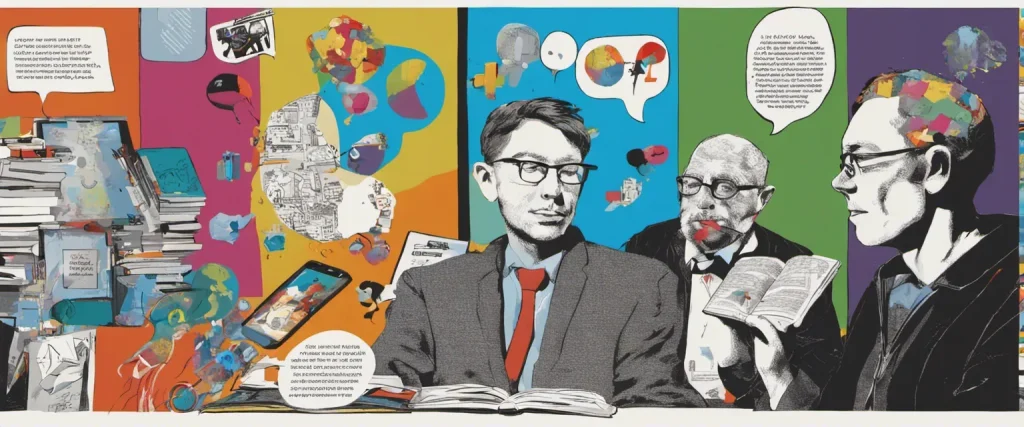In the groundbreaking book, Freakonomics, renowned economist Steven D. Levitt delves into the unexpected connections between seemingly unrelated subjects, providing unique insights into the hidden world of economics and human behavior. With Levitt’s expertise and unconventional approach, this captivating and thought-provoking work challenges traditional assumptions and invites readers to explore the fascinating world of incentives, statistics, and unconventional thinking. As a distinguished professor at the University of Chicago, Levitt’s innovative research has earned him global recognition, making him an influential figure in the field of economics. Through the lens of his unconventional perspective, Levitt illuminates the intricate complexities behind everyday phenomena, allowing readers to perceive the world with a fresh and insightful lens.
Chapter 1: Introduction to the Hidden Side of Economics
In Chapter 1, the author examines how using the tools of economics can uncover hidden truths about human behavior and challenge commonly held beliefs.
The chapter begins by introducing the concept of incentives, emphasizing that people respond to incentives, whether they are positive or negative. Levitt argues that incentives lie at the heart of economics and can help explain why people do what they do.
He then delves into a case study on the economics of cheating in the field of sumo wrestling. Levitt highlights the significant financial incentives for sumo wrestlers to win matches and maintain their rank, which leads them to engage in collusion and match-fixing. By analyzing the patterns of behavior, Levitt and his collaborator were able to identify suspicious instances of cheating. This case study not only demonstrates the power of incentives but also introduces the idea that by examining the right data and patterns, even complex social phenomena can be understood and explained.
The chapter also touches upon the importance of data in making informed decisions and understanding human behavior. Levitt argues that gathering and analyzing data is crucial in uncovering hidden truths. He criticizes the reliance on traditional methods, such as surveys and experiments, which are often unreliable due to people’s inherent biases.
Overall, the chapter asserts the importance of applying economic principles and analytical thinking to understand complex societal issues. Levitt challenges conventional wisdom, arguing that by focusing on incentives and gathering unconventional data, economists can unveil the hidden side of human behavior and shed light on the underlying forces that shape our lives.
Chapter 2: Cheating in Sumo Wrestling
Steven D. Levitt explores the realm of professional sumo wrestling in Japan and uncovers a scandal involving widespread match-fixing and cheating within the sport.
The chapter begins by shedding light on the traditional and revered image of sumo wrestling, emphasizing its deep-rooted history and cultural significance in Japan. However, Levitt’s examination reveals a more sinister side to the sport.
By analyzing extensive data on sumo matches over several years, Levitt discovers evidence of systematic cheating. He focuses on a peculiar pattern in the final matches of each tournament, where the wrestler with seven wins and seven losses suddenly faces off against a wrestler with only seven wins. Normally, such matchups would not occur as both wrestlers would not have qualified for the final round.
Intrigued, Levitt concludes that the anomaly is the result of match-fixing. Wrestlers who had already secured their place in the final round purposefully lost their matches, allowing wrestlers with fewer wins but higher ranks to qualify. This manipulation increased the likelihood of securing a promotion in rank for the wrestlers involved in the scheme.
To further support his findings, Levitt delves into the unseen world of sumo wrestling stables, where wrestlers live and train under strict conditions. He interviews insiders who provide insights into the pressure placed on wrestlers by their handlers to cheat in order to preserve the hierarchy of power and maintain stability within the sport.
The chapter concludes with the revelation that following the publication of Levitt’s research, the sumo scandal came to light. Several wrestlers confessed to fixing matches, leading to public outrage and a significant blow to the reputation of the sport. This chapter serves as an exposé on the dark underbelly of sumo wrestling and the pervasive nature of cheating within an esteemed cultural institution.
Chapter 3: The Economics of Drug Dealing
Chapter 3 delves into the economic forces driving the illegal drug trade. Authors Steven D. Levitt and Stephen J. Dubner approach this topic by applying economic theories to the understanding of drug dealing, challenging conventional wisdom and shedding light on the realities of the industry.
The chapter begins by highlighting the vast potential earnings of drug dealers, suggesting that successful drug dealers could make more money than their legitimate peers. However, the authors argue that the vast majority of drug dealers make little income, leading to several questions: Why do so many people become drug dealers if the returns are low? How does the industry persist despite serious legal consequences?
Using economic analysis, the authors explain that the drug market operates as a hierarchical system, resembling a corporate structure. A select few individuals at the top, known as “kingpins,” enjoy massive profits, while the majority of street-level dealers earn meager wages. This hierarchical model is made possible by economic principles such as risk-taking behavior, supply and demand dynamics, and the incentive to maintain control over the drug trade.
Levitt and Dubner use data from an innovative research project that involved interviewing drug dealers, gaining insights into the inner workings of the industry. They found that the low-level street dealers are essentially taking on a highly risky and poorly paid job. However, they engage in drug dealing due to a lack of better opportunities or educational prospects within their socio-economic environments.
In conclusion, Chapter 3 of “Freakonomics” provides a fascinating analysis of the economics behind the drug trade. By understanding the economics of drug dealing, the authors challenge common assumptions and shed light on the motivations and mechanics that enable the illegal drug market to persist despite its inherent risks and meager returns for most participants.
Chapter 4: The Impact of Legalized Abortion

Chapter 4 delves into the controversial relationship between abortion and crime rates in the United States. Levitt and his co-author, John Donohue, explore the unexpected consequences of the Supreme Court’s landmark decision in 1973, which legalized abortion in the Roe v. Wade case.
The chapter begins by presenting an intriguing hypothesis: that the decrease in crime rates observed in the 1990s can be partly attributed to the legalization of abortion in the 1970s. Levitt argues that unwanted children, who may have been born due to unwanted pregnancies prior to the legalization of abortion, are more likely to grow up in disadvantaged environments that contribute to criminal behavior later in life.
Through rigorous statistical analysis and utilizing various sets of data, Levitt and Donohue attempt to substantiate this hypothesis. They examine the relationship between the number of abortions performed in each state after Roe v. Wade and the subsequent decrease in crime rates two decades later. Their research suggests that crime rates have indeed declined more significantly in states with high abortion rates.
The authors posit that the availability of abortion gave women more control over their reproductive choices, allowing them to delay motherhood until they were more prepared and willing to become parents. Consequently, fewer children grow up in adverse environments, such as poverty or unstable households, which are known risk factors for criminal behavior.
This controversial argument challenges the conventional wisdom surrounding crime and its causes. Levitt’s economic perspective sheds light on the unexpected potential benefits of legalized abortion, suggesting that it may have contributed to a significant reduction in crime rates in the United States.
Chapter 5: The Influence of Parenting
Chapter 5 explores the concept of nature versus nurture and challenges traditional assumptions about the impact of parenting on children’s outcomes. Authors Steven D. Levitt and Stephen J. Dubner delve into research that examines various factors that shape a child’s life, such as genes, socioeconomic status, and more, alongside the role of parents.
The chapter begins by discussing how economists, unlike sociologists, psychologists, or parenting experts, tend to believe that parenting has a limited influence on a child’s development. Levitt and Dubner argue that the observed correlations between good parenting practices and successful children may not necessarily imply causation. They present various social factors that overshadow the impact of parenting, such as the influence of genes and the socioeconomic background of the child’s family.
To support their case, the authors refer to several studies and highlight how factors previously assumed to be influenced by parenting, such as the child’s academic performance, are found to be more closely tied to their genetic makeup. Moreover, they introduce the concept of “peers” and argue that some of the effects attributed to parenting might actually be influenced by the company children keep.
Levitt and Dubner then delve into the fascinating topic of parenting styles and discuss the “parental investment theory.” They introduce a controversial hypothesis stating that the time parents spend with their children is less significant than what parents actually do with that time. Blending in anecdotes and statistical analysis, they conclude that parents’ investment in their children’s life choices, through teaching them to think independently and encouraging them to question authority, can have a lasting impact that supersedes the traditional practices often associated with “good parenting.”
In summary, Chapter 5 of Freakonomics challenges the assumption that parenting has a universally significant influence on a child’s life outcomes. It suggests that other factors, such as genetics and the child’s environment, may play a more significant role. This chapter prompts readers to reconsider commonly held beliefs about parenting and encourages them to question the conventional wisdom surrounding this subject.
Chapter 6: The Power of Information
Chapter 6 explores the concept of information and its impact on various aspects of society. Levitt examines the role of information in revealing truth and dispelling myths, identifying incentives, and potentially changing behavior.
The chapter begins by focusing on the real estate market and the lack of transparency in pricing homes. Traditional real estate agents often fail to disclose accurate information, intentionally misrepresenting properties to secure higher commissions. Levitt argues that the Internet and the availability of online property databases have disrupted this information imbalance, empowering consumers by providing them with accurate data. As a result, real estate agents had to adjust their behavior.
Levitt then delves into the impact of information on the crime rate. He suggests that legalized abortion in the 1970s had a profound effect on reducing crime rates in the 1990s. By analyzing data, he finds that the children who would have grown up in crime-prone environments had their lives and potential criminal behavior effectively eliminated before they were born. This controversial theory challenges conventional thinking on crime prevention.
Furthermore, the chapter explores the use of information in education. Levitt examines standardized testing and its effectiveness in assessing educational outcomes. He argues that educational outcomes are poorly correlated with school quality, but rather more influenced by external factors such as parents’ socioeconomic status and educational background.
Lastly, Levitt explores the power of information in the form of parenting. He highlights the lack of impact of various factors, such as reading to children, on their cognitive development. According to his analysis, information about a child’s natural abilities is a more important determinant of academic success.
Overall, Chapter 6 of “Freakonomics” demonstrates how information can help uncover truths, challenge prevailing beliefs, and reshape our understanding of various social phenomena.
Chapter 7: Exploring Names and Social Status
Chapter 7 explores the relationship between names and social status. Levitt begins by discussing how names can act as an indicator of socioeconomic background and cultural factors, reflecting the choices parents make when naming their children.
Levitt examines naming patterns across different groups and communities, highlighting the differences in naming conventions. He particularly focuses on African-American names, which often differ significantly from naming traditions in other ethnic groups. Levitt argues that the divergence in naming styles can influence various outcomes, including potential educational and career opportunities.
The chapter delves into a study conducted by Levitt and his colleague Roland Fryer, which examines the impact of distinctively African-American names on children’s academic success. The study finds that children with more common, conventionally “white” names tend to perform better academically compared to their peers with more uniquely African-American names. Levitt presents these findings alongside the argument that these names may lead to implicit bias and discrimination from teachers and employers.
Levitt also raises the intriguing correlation between people’s names and their potential future success. He analyzes data showing that individuals with certain names tend to pursue careers in fields associated with higher social status, while others opt for lower-status professions. Additionally, he explores the possibility of names being connected to criminal behavior, suggesting that certain names may predispose individuals to engage in criminal activities due to societal expectations and stereotypes.
Overall, Chapter 7 of “Freakonomics” highlights the powerful influence that names can have on social status, education, and career outcomes, emphasizing the complex relationship between names and the opportunities individuals are afforded in life.

Chapter 8: Wrapping Up: What Do Schoolteachers and Sumo Wrestlers Have in Common?
In this chapter, Levitt concludes the book by exploring unlikely correlations and their underlying causes.
The chapter begins by discussing cheating among teachers in schools. Levitt presents a study showing a suspicious spike in students’ test scores in certain classrooms. Through statistical analysis, Levitt discovers that these teachers are cheating to meet their performance targets and secure financial rewards. He emphasizes the power of incentives in motivating such behavior.
Moving on, Levitt reveals an intriguing connection between sumo wrestlers and teachers: the importance of motivation. He asserts that incentives significantly influence individuals’ behavior, whether it is teachers trying to improve test scores or sumo wrestlers trying to win matches. Levitt argues that the presence of extrinsic motivation, such as financial rewards or punishments, can shape people’s actions.
Furthermore, the chapter discusses how information asymmetry plays a crucial role in several scenarios. Levitt examines the drug-dealing business and explains how low-level drug dealers earn surprisingly low wages compared to the risk they undertake. He argues that lack of information about alternatives and the risk-reward imbalance are contributing factors.
Levitt further explores the role of information asymmetry in the parenting market, uncovering the sometimes irrational decisions parents make when it comes to their children’s education. He suggests that parents do not always make well-informed choices due to the complexity of education and a lack of adequate information.
In the final sections of the chapter, Levitt reflects on the power of economics and how it can provide valuable insights into seemingly unrelated subjects. He encourages readers to approach problems with a different perspective, emphasizing the importance of incentives, hidden information, and thinking outside the box.
In summary, Chapter 8 of “Freakonomics” establishes connections between cheating teachers, sumo wrestlers, drug dealers, and parent’s decision-making, highlighting the underlying motivations and information asymmetry that shape their actions and choices. Levitt concludes the book by demonstrating the value of applying economic principles to uncover surprising and unconventional truths about the world around us.
After Reading
In conclusion, Freakonomics by Steven D. Levitt presents a unique outlook on various social and economic phenomena by employing unconventional methods and combining economics with other disciplines. The book challenges conventional wisdom and offers alternative explanations for complex issues such as crime rates, parenting strategies, and the impact of names on individuals’ lives. Levitt’s groundbreaking research and analysis provide thought-provoking insights, encouraging readers to question traditional assumptions and explore the hidden factors that drive human behavior. Freakonomics provides an engaging and eye-opening read, highlighting the power of economic thinking in understanding the world around us.
1. Thinking, Fast and Slow” by Daniel Kahneman: This book explores the two systems of thinking that govern our decision-making process. Drawing on decades of research, Kahneman provides insights into the biases and errors that affect our judgments and offers practical advice on making smarter choices.
2. Nudge: Improving Decisions About Health, Wealth, and Happiness” by Richard H. Thaler and Cass R. Sunstein: Thaler and Sunstein delve into the concept of “choice architecture” – how the way choices are presented can significantly influence decision outcomes. They discuss how small changes can nudge people towards making better choices, helping individuals and societies achieve improved well-being.
3. Predictably Irrational: The Hidden Forces That Shape Our Decisions” by Dan Ariely: In this engaging and accessible book, Ariely uncovers the irrational forces that can lead us astray in our decision-making. With thought-provoking experiments and real-life examples, he reveals the predictable patterns behind our seemingly irrational choices and offers insights on how to overcome them.
4. Influence: The Psychology of Persuasion” by Robert B. Cialdini: Expanding on the power of persuasion, Cialdini explores the underlying psychological principles that compel people to say “yes.” Through six key principles, he uncovers the tactics used by compliance professionals and shares how to defend against manipulation while becoming more persuasive ourselves.
5. “Thinking in Bets: Making Smarter Decisions When You Don’t Have All the Facts” by Annie Duke: Drawing on her experience as a professional poker player, Duke explains how to make better decisions in an uncertain world. She discusses the importance of thinking in probabilities, the illusion of certainty, and how to improve decision-making processes by embracing uncertainty.
These five books, along with the listed readings, provide a diverse collection of insights into decision-making, behavioral economics, and the psychology behind our choices. By exploring these works, readers can gain valuable knowledge and tools to understand and improve their decision-making abilities in various aspects of life.



